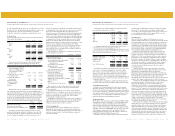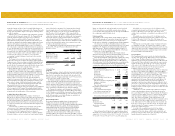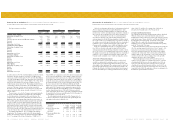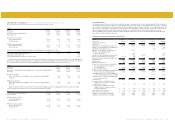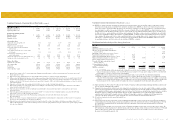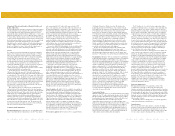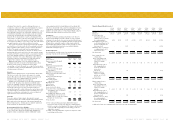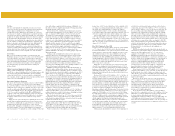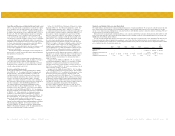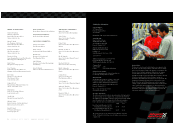Advance Auto Parts 2001 Annual Report Download - page 28
Download and view the complete annual report
Please find page 28 of the 2001 Advance Auto Parts annual report below. You can navigate through the pages in the report by either clicking on the pages listed below, or by using the keyword search tool below to find specific information within the annual report.
50 ADVANCE AUTO PARTS ANNUAL REPORT 2001 ADVANCE AUTO PARTS ANNUAL REPORT 2001 51
Senior Discount Debentures and Industrial Revenue Bonds. In April
1998, in connection with the recapitalization, we issued $112.0 million
in face amount of senior discount debentures (“the debentures”). The
debentures accrete at a rate of 12.875%, compounded semi-annually, to
an aggregate principal amount of $112.0 million by April 15, 2003. At
December 29, 2001, $95.4 million principal amount was outstanding.
Commencing April 15, 2003, cash interest on the debentures will
accrue and be payable semi-annually at a rate of 12.875% per annum.
The indenture governing the debentures contains certain covenants that,
among other things, limit our ability and the ability of our restricted
subsidiaries to incur indebtedness and issue preferred stock, repurchase
stock and certain indebtedness, engage in transactions with affiliates,
create or incur certain liens, pay dividends or certain other
distributions, make certain investments, enter into new businesses, sell
stock of restricted subsidiaries, sell assets and engage in certain
mergers and consolidations.
Our obligations relating to the industrial revenue bonds include an
interest factor at a variable rate and will require no principal payments
until maturity in November 2002.
Seasonality
Our business is somewhat seasonal in nature, with the highest sales
occurring in the spring and summer months. In addition, our business
can be affected by weather conditions. While unusually heavy
precipitation tends to soften sales as elective maintenance is deferred
during such periods, extremely hot or cold weather tends to enhance
sales by causing automotive parts to fail.
Recent Accounting Pronouncements
In June 1998, the Financial Accounting Standards Board (“FASB”)
issued SFAS No. 133, “Accounting for Derivative Instruments and
Hedging Activities”. This Statement establishes accounting and
reporting standards for derivative instruments, including certain
derivative instruments embedded in other contracts (collectively
referred to as derivatives) and for hedging activities. It requires
companies to recognize all derivatives as either assets or liabilities in
their statements of financial position and measure those instruments at
fair value. In September 1999, the FASB issued SFAS No. 137,
“Accounting for Derivative Instruments and Hedging Activities--
Deferral of the Effective Date of FASB Statement No. 133,” which
delayed the effective date of SFAS No. 133 to fiscal years beginning
after June 15, 2000, the FASB issued SFAS No. 138, “Accounting for
Derivative Instruments and Certain Hedging Activities--an Amendment
of SFAS No. 133,” which amended the accounting and reporting
standards for certain risks related to normal purchases and sales,
interest and foreign currency transactions addressed by SFAS No. 133.
We adopted SFAS No. 133 on December 31, 2000 with no material
impact on our financial position or results of operations.
In September 2000, the FASB issued SFAS No. 140, “Accounting for
Transfers and Servicing Financial Assets and Extinguishment of Liabilities”.
This statement replaces SFAS No. 125, but carries over most of the
provisions of SFAS No. 125 without reconsideration. We implemented
SFAS No. 140 during the first quarter of 2001. The implementation had no
impact on our financial position or results of operations.
In June 2001, the FASB issued Statements of Financial Accounting
Standards (“SFAS”) No. 141, “Business Combinations” and No. 142,
“Goodwill and Other Intangible Assets,”. SFAS No. 141 addresses
accounting and reporting for all business combinations and requires the
use of the purchase method for business combinations. SFAS No. 141
also requires recognition of intangible assets apart from goodwill if
they meet certain criteria. SFAS No. 142 establishes accounting and
reporting standards for acquired goodwill and other intangible assets.
Under SFAS No. 142, goodwill and intangibles with indefinite useful
lives are no longer amortized but are instead subject to at least an
annual assessment for impairment by applying a fair-value based test.
SFAS No. 141 applies to all business combinations initiated after June
30, 2001. SFAS No. 142 is effective for our existing goodwill and
intangible assets beginning on December 30, 2001. SFAS No. 142 is
effective immediately for goodwill and intangibles acquired after June
30, 2001. For 2001, we had amortization expense of approximately
$444 related to existing goodwill of $3,251 at December 29, 2001.
Such amortization will be eliminated upon adoption of SFAS No. 142.
Although we are currently evaluating the impact of other provisions of
SFAS Nos. 141 and 142, we do not expect that the adoption of these
statements will have a material impact on our financial position or
results of operations.
In August 2001, the FASB issued SFAS No. 143, “Accounting for
Asset Retirement Obligations.” SFAS No. 143 establishes accounting
standards for recognition and measurement of an asset retirement
obligation and an associated asset retirement cost and is effective for
2003. We do not expect SFAS No. 143 to have a material impact on our
financial position or results of operations.
In August 2001, the FASB also issued SFAS No. 144, “Accounting
for the Impairment or Disposal of Long-Lived Assets”. This statement
replaces both SFAS No. 121, “Accounting for the Impairment of Long-
Lived Assets and for Long-Lived Assets to Be Disposed Of ” and
Accounting Principles Board (APB) Opinion No. 30, “Reporting the
Results of Operations--Reporting the Effects of Disposal of a Segment
of a Business, and Extraordinary, Unusual and Infrequently Occurring
Events and Transactions.” SFAS 144 retains the basic provisions from
both SFAS 121 and APB 30 but includes changes to improve financial
reporting and comparability among entities. We will adopt the
provisions of SFAS 144 during the first quarter of 2002. We do not
expect the adoption of SFAS No. 144 to have a material impact on our
financial position or results of operations.
Quantitative and Qualitative Disclosures about Market Risks
We currently utilize no material derivative financial instruments that expose us to significant market risk. We are exposed to cash flow and fair value risk
due to changes in interest rates with respect to our long-term debt. While we cannot predict the impact interest rate movements will have on our debt,
exposure to rate changes is managed through the use of fixed and variable rate debt. Our future exposure to interest rate risk decreased during 2001 due to
decreased interest rates and reduced variable rate debt.
Our fixed rate debt consists primarily of outstanding balances on our senior discount debentures and senior subordinated notes. Our variable rate debt
relates to borrowings under the senior credit facility and the industrial revenue bonds. Our variable rate debt is primarily vulnerable to movements in the
LIBOR, Prime, Federal Funds and Base CD rates.
The table below presents principal cash flows and related weighted average interest rates on long-term debt we had outstanding at December 29, 2001,
by expected maturity dates. Expected maturity dates approximate contract terms. Fair values included herein have been determined based on quoted
market prices. Weighted average variable rates are based on implied forward rates in the yield curve at December 29, 2001. Implied forward rates should
not be considered a predictor of actual future interest rates.
Fair
Fiscal Fiscal Fiscal Fiscal Fiscal Market
(dollars in thousands) 2002 2003 2004 2005 2006 Thereafter Total Value
Long-term debt
Fixed rate -----$481,450 $ 481,450 $ 457,804
Weighted average interest rate -----10.9%10.9%
Variable rate $ 23,715 $ 32,385 $ 48,578 $ 53,975 $ 63,975 $ 282,372 $ 505,000 $ 505,000
Weighted average interest rate 5.9% 7.9% 9.1% 9.5% 9.9% 10.3% 8.6%


